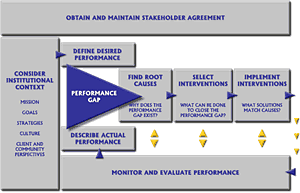 |
||||
|
||||
|
|
 |
|
Performance Improvement (PI) is a method for analyzing performance problems and setting up systems to ensure good performance. PI is applied most effectively to groups of workers within the same organization or performing similar jobs. While PI principles are relevant to workers in any field, this publication focuses on primary providers of family planning and reproductive health (FP/RH) care services. Overview of Performance ImprovementPerformance refers to the way people do their jobs and the results of their work. Organizations seeking to solve a performance problem frequently implement a specific intervention, such as training, without fully understanding the nature of the problem or determining whether or not the chosen intervention is likely to succeed. Just as often, professionals with a high level of expertise in a specific intervention area see every problem as an opportunity to ply their trade. As Abraham Maslow once said, “To the person who only has a hammer in the toolkit, every problem looks like a nail.” In fact, there are a number of methods for improving the performance of organizations, teams and individuals. Organizational development, industrial engineering, training and development, quality assurance, and human resources development address performance gaps in particular ways. Performance Improvement differs from these approaches by using a systematic methodology to find the root causes of a performance problem and then implement an intervention (or “fix”) that applies to that specific performance deficit. The PRIME II Performance Improvement Approach (PIA) is not a new intervention. Nor is it intended to replace other successful interventions or programs such as USAID’s Maximizing Access and Quality (MAQ) initiative, EngenderHealth’s Client-Oriented Provider-Efficient (COPE) services, Quality Assurance, Situation Analysis or Whole Site Training, one or more of which may already be in place when PI is implemented. Rather, the PI methodology offers a set of tools that can be used independently or in conjunction with other interventions to improve the accessibility and quality of FP/RH services. Too often, FP/RH interventions have failed to build the capacity of organizations to sustain improved services or even to improve services at all. PI helps to ensure that selected interventions are supported and sustained by involving a stakeholder group from the outset and ensuring that an organization’s staff participates actively in every step of the process. Factors That Affect PerformanceCertain factors need to be in place for workers to be able to perform well on their jobs:
Successful organizations support their workers by instituting and sustaining these performance factors. This support can be provided by a supervisor or emanate from a variety of other sources. For example, feedback can come from clients and incentives from a peer group. But no matter the source of these performance factors, it is the responsibility of the organization to make sure that a system is in place to deliver them. When a performance factor is missing and a gap in performance has occurred, a solution, or intervention, usually becomes clear. For example, if workers lack information about what is expected of them, obvious interventions would include implementation of written policies, job descriptions or verbal directions. The PI facilitator considers the entire human performance system by looking at the desired performance of workers and the organizations they work for. This approach does not presuppose any particular type of intervention; rather, it allows the PI facilitator and the stakeholder group to choose appropriate interventions once the problem is clear. Often, the PI practitioner will not have expertise in a needed intervention but will call on other professionals for that expertise—for example, bringing in instructional designers if training is required. The PI Process FrameworkThe following graphic illustrates the typical PI process: Following is a more detailed discussion of each of the stages in the PI process. Consider Institutional ContextBefore taking the first steps in the PI process, the facilitator must understand the institutional context within which performance improvement will take place. The facilitator must be aware of the goals of the larger organization and maintain a consistent direction when defining performance targets. Familiarity with organizational goals—from the very top down to the level at which the main interventions will take place—helps to ensure the sustainability of the interventions. In a given project, for example, the facilitator and the stakeholders may need to know the goals of the ministry of health, the safe motherhood program and the postabortion care initiatives going on nationwide. (Jump to this stage.) Obtain and Maintain Stakeholder AgreementA client initiates the PI process by asking for assistance with problems or performance situations. In the initial stage, the PI facilitator, the client and the stakeholders meet to discuss and define the desired outcomes of the activity. During the discussion, this group also addresses some or all of the following questions:
This dialogue is important as it creates a collaborative working relationship that will continue for the life of the project. Throughout the PI process, the facilitator will ensure that there is common understanding and project agreement among the stakeholders. (Jump to this stage.) Define Desired PerformanceThe stakeholder group creates verbal statements that define desired performance in specific, observable and measurable terms. These statements of desired performance address the quality, quantity and timeliness of performance (i.e., how well, how many, when?). The group then sets initial and final target levels of performance. This cooperative work to define desired performance is vital for building consensus among the stakeholders and achieving the desired outcome of the project. (Jump to this stage.) Describe Actual PerformanceOnce desired performance is described to everyone’s satisfaction, current levels of performance are assessed using the same indicators developed to describe desired performance. Typically, describing actual performance levels necessitates baseline data collection. (Even though the data will not be used until the root cause analysis stage, it is usually most efficient to gather information about the presence or absence of performance factors at the same time you gather the baseline data.) While the description of actual performance usually follows the definition of desired performance, in some cases the order may be reversed. (Jump to this stage.) Describe Performance GapsOnce the desired and actual levels of performance have been defined, identifying the performance gaps becomes a simple matter of comparing the two levels. The gap should be described using the same indicators that were employed to describe desired and actual performance. The gap description shows, in objective terms, the difference between current performance and the performance the client wants to achieve. This stage usually involves prioritizing which performance gaps to address, as more than one will likely be identified. Discussions are also necessary to make sure the gaps that are identified are important enough and wide enough to merit further work. (Jump to this stage.) Find Root CausesOnce performance gaps have been described, the next step is to determine the cause of those gaps. Using the performance factors as a starting point, the stakeholder group participates in a root cause analysis to uncover the environmental factors that are impeding good performance. Any of the proven root cause analysis techniques (e.g., fishbone diagram, why-why analysis) will serve here. In PI, the analysis that concludes with the finding of root causes is frequently called a “Performance Needs Assessment” (PNA). Note: When applying PI to new performance (e.g., a job that has never been done before), some of these steps might be eliminated, as the focus will be on setting up an enabling system rather than solving an existing problem. (Jump to this stage.) Select and Design InterventionsThe stakeholder group next selects interventions that will address the root causes discovered during the previous stage. Each intervention or set of interventions must address at least one root cause. During this stage, the team consults experts in each possible intervention area and plays a major role in designing and developing the selected interventions. (Jump to this stage.) Implement InterventionsDuring the implementation stage, the team recruits additional expertise as needed, assures organizational readiness, applies the interventions, and helps enable and monitor organizational change. (Jump to this stage.) Monitor and Evaluate PerformanceThrough monitoring and evaluation, the team measures the change in the performance gaps identified during gap analysis. Monitoring happens on an ongoing basis so that changes in implementation can be made as needed. Whenever possible, the team develops an evaluation method that can be integrated into workplace processes and remain in the workplace after the interventions as a feedback device for workers and managers. The final evaluation should remeasure the performance gaps and assess the extent to which they have closed as a result of the interventions. (Jump to this stage.) |
